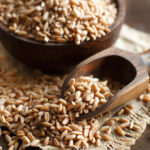How To Cook Quinoa – Healthy Video

What Is Quinoa?
Quinoa (pronounced “keen-wah”), is commonly called a grain, but is actually a pseudocereal, or a seed of a broadleaf plant (true cereals are the seeds of grasses). A relative of beets, Swiss chard and spinach, quinoa is referred to as a grain because it is prepared and eaten in a similar manner as other healthy whole grains such as barley, brown and wild rice, and steel-cut oats.
4 Health Benefits Of Quinoa
Quinoa offers a variety of health benefits – they are:
- High in magnesium – magnesium helps relax blood vessels, which may result in less frequent headaches for migraine sufferers, and a decreased risk of stroke or hypertension.
- A good source of iron, manganese, copper, vitamin B12, phosphorous and other essential minerals.
- The richest source of protein of any grain. Quinoa’s protein is complete – it contains all nine essential amino acids, which is a rarity in the plant kingdom. It is especially high in lysine, an amino acid that is typically low in other grains.
- Gluten-free and easy to digest.
How To Cook Quinoa?
Quinoa is easy to cook – watch our How To Make Healthy: Quinoa video for step-by-step instructions!
Cooking quinoa takes only 15 to 20 minutes. One step that is required for quinoa is to rinse it before cooking – pre-washing quinoa in a fine mesh strainer (rub the seeds lightly between your fingers under the running water) will help to remove the bitter saponin coating.
Once you are done rinsing, simply place one cup of quinoa in two cups of cold water, then cover and bring to a boil.
Once it is at a boil, reduce the heat and simmer for about 15 minutes until the quinoa is translucent. Fluff with a fork and your quinoa is ready.
Types Of Quinoa
There are over 120 varieties of quinoa, but the most commonly available are white, red and black.
- White Quinoa: Probably the most common form in the United States, white quinoa is an excellent substitute for white rice.
- Red Quinoa: This type is reported to better hold its shape after cooking, making it a good choice for cold or room temperature dishes, where the dish may call for the grain to be more distinct. Red quinoa is also a good choice when a recipe calls for quinoa to be mixed with wet ingredients for a period of time.
- Black Quinoa: This variety has a sweeter and more earthy flavor than the other two, making it a good choice for breakfast or dessert recipes.

What Makes Whole Grains Healthy?
Whole grains are part of Dr. Weil’s Anti-Inflammatory Food Pyramid. They are included because they are good vegetarian sources of vitamins, protein, fiber and minerals. Whole grains also digest slowly, reducing frequency of spikes in blood sugar that promote inflammation and lead to insulin resistance – a major driver of type 2 diabetes, high blood pressure and obesity. Dr. Weil recommends three to five servings of whole grains per day as part of the Anti-Inflammatory Diet.
How Can Quinoa Be Used?
Quinoa is very versatile, and can be used in:
- Salads, both warm and cold, as an additional protein source
- As a replacement for white rice or pasta in a variety of dishes
- As part of a breakfast or lunch smoothie bowl
- In casseroles and baked goods
Healthy Quinoa Recipes
Try your quinoa in these recipes:
Step By Step: How To Make Healthy Quinoa
- 1 Cup uncooked quinoa
- 2 Cups water
- Rinse quinoa under cold water (Pre-washing removes the soap-like components called saponins that can taste bitter and have a laxative effect)
- Put quinoa and water into pot over high heat and bring to a boil
- Reduce heat and simmer for 15 minutes
- Once grains become translucent, fluff with fork
- Transfer to bowl
- Enjoy your healthy quinoa!













